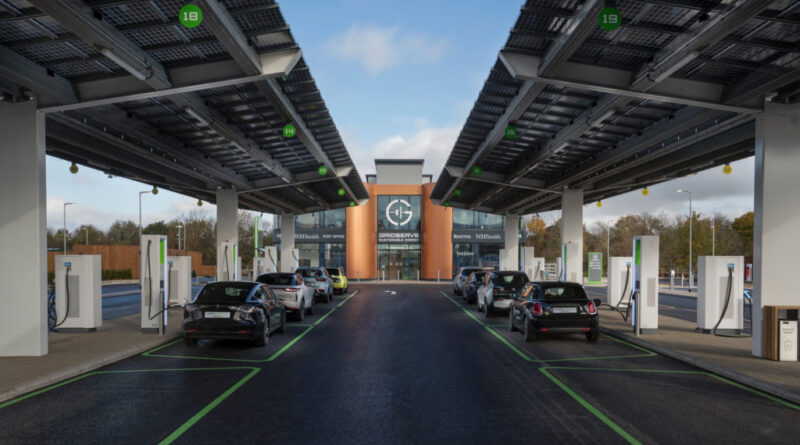UK’s first dedicated electric car forecourt shows Australia the way
The UK’s first Electric Forecourt has been opened by Gridserve to support mass market EV charging and make charging EVs “less expensive than petrol or diesel alternatives.”
It offers a taster of what Australian EV drivers can expect once our electric vehicle take-up justifies such infrastructure investment. Green shoots are emerging here, but we’re many years behind other markets.
The forecourt, near Braintree, Essex – some 100km from London – allows 36 electric vehicles to be charged simultaneously with chargers delivering from 7kW up to 350kW charging power, using, Gridserve says, net zero carbon energy.
Importantly, all 36 chargers can be used at the same time without charge output dropping – the bane of many EV owners charging at busy stations with multiple chargers.

Gridserve has ensured those charging at its Electric Forecourt needn’t get bored. There’s the expected retail outlets – newsagent, coffee shop, fancy supermarket and post office – plus a waiting lounge, high-speed wi-fi, kid’s area and business meeting room with pods.
Most intriguing is a “wellbeing area” complete with exercise bikes that generate electricity. Hop on, turn the pedals over and watch as you self-charge your car while getting your daily workout. Not sure many stationary cyclists will achieve that 350kW power figure however.
The UK has a pressing need to implement such forecourts due to its government banning sales of petrol and diesel cars from 2030, and Gridserve said its Braintree Electric Forecourt was the first of a planned 100 to be opened in the next five years, financially backed by Hitachi Capital (UK) PLC and government-backed Innovate UK. Sounds optimistic, but there’s little doubt interest and the need for such outlets are rapidly increasing.

So, some questions. How is the electricity generated and how much does it cost to charge?
Gridserve said drivers charging would “initially pay just 24p per kWh of energy, which is currently the lowest ultra-high power charging rates on the market today.” That translates to about 43c per kWh in Australian currency. Tesla currently charges 52c per kWh for owners to use its Superchargers, while Evie Networks charges 40c per kWh for its 50kW fast chargers and 60c per kWh its 350kW ultra-rapid chargers, while Chargefox’s 350kW ultra-rapid chargers have an introductory price of 40c per kWh.
It’s worth remembering Telsa’s Supercharger network is currently restricted up to 120kW, while only the incoming Porsche Taycan has 350kW DC fast-charging capacity.
At Gridserve’s 43c per kWh rate, it suggests at the Electric Forecourt a typical charge from 20 percent to 80 percent would cost less than £10 ($18) for an average-size electric vehicle. It did reveal there were plans to introduce a tiered pricing structure in future, no doubt based on how fast the charger is.

As for how green the Electric Forecourt is, Gridserve explained its electricity is “generated from both the solar power canopies above the chargers, and a network of hybrid solar farms … providing 100 percent renewable energy via the National Grid.
“There is also a 6MWh (6000kWh) battery onsite which helps to balance the local energy grid and shift energy to periods when it is more valuable. For example, on windy winter nights the battery can store enough energy to drive 24,000 miles (39,000km) in electric vehicles the following day, helping to maximise the value of renewable energy resources, stabilise the grid, and keep prices low.”
Casual visitors to the Electric Forecourt can access a flash-looking upstairs area which “showcases the latest electric vehicles, and there are multiple digitals screens that help people learn about and source electric vehicles.”





This is a brilliant ev charging site. It also caters for a limited number of ICE vehicles. You can watch an excellent video of this electric forecourt via the “fullycharged” YouTube channel. Australia is so lagging behind with ev take up that we will become a laughing stock very soon if nothing is done to encourage them.